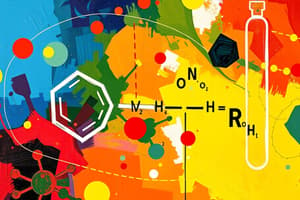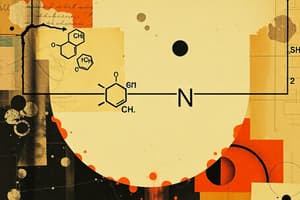Podcast
Questions and Answers
What is a characteristic of the SN1 mechanism?
What is a characteristic of the SN1 mechanism?
- Inversion of stereochemistry at the reaction center
- Formation of a carbocation intermediate in the rate-determining step (correct)
- Second-order kinetics
- Racemic mixture of products
Which type of substrate favors the SN1 mechanism?
Which type of substrate favors the SN1 mechanism?
- Secondary alkyl halides
- Aromatic compounds
- Tertiary alkyl halides (correct)
- Primary alkyl halides
What is a characteristic of electrophilic substitution?
What is a characteristic of electrophilic substitution?
- Attack of an electrophile on an aromatic ring (correct)
- Inversion of stereochemistry at the reaction center
- Formation of a carbocation intermediate
- Replacement of a leaving group by a nucleophile
What is a factor that affects nucleophilic substitution?
What is a factor that affects nucleophilic substitution?
What is the type of mechanism involved in SN2 reaction?
What is the type of mechanism involved in SN2 reaction?
What is the rate-determining step in the SN1 mechanism?
What is the rate-determining step in the SN1 mechanism?
What is the primary difference between nucleophilic and electrophilic substitution reactions?
What is the primary difference between nucleophilic and electrophilic substitution reactions?
What is the role of the leaving group in a nucleophilic substitution reaction?
What is the role of the leaving group in a nucleophilic substitution reaction?
How does the SN1 mechanism differ from the SN2 mechanism in terms of stereochemistry?
How does the SN1 mechanism differ from the SN2 mechanism in terms of stereochemistry?
What is the rate-determining step in the SN2 mechanism?
What is the rate-determining step in the SN2 mechanism?
What is the significance of carbocation stability in the SN1 mechanism?
What is the significance of carbocation stability in the SN1 mechanism?
What is a key difference between alkyl halides and aromatic compounds in terms of substitution reactions?
What is a key difference between alkyl halides and aromatic compounds in terms of substitution reactions?
Flashcards are hidden until you start studying
Study Notes
Substitution in Organic Chemistry
SN1 Mechanism
- Unimolecular nucleophilic substitution: a two-step mechanism
- Step 1: Formation of a carbocation intermediate (rate-determining step)
- Step 2: Nucleophile attacks the carbocation to form the product
- Characteristics:
- First-order kinetics (rate depends on substrate concentration)
- Racemic mixture of products (no stereospecificity)
- Rearrangement of the carbocation possible
- Favoured by:
- Tertiary alkyl halides
- Polar solvents
- High temperatures
SN2 Mechanism
- Bimolecular nucleophilic substitution: a one-step mechanism
- Concerted mechanism: nucleophile attacks from the backside of the leaving group
- Characteristics:
- Second-order kinetics (rate depends on substrate and nucleophile concentrations)
- Inversion of stereochemistry at the reaction center
- No carbocation intermediate
- Favoured by:
- Primary alkyl halides
- Good nucleophiles (e.g., NH₃, CN⁻)
- Aprotic solvents
Electrophilic Substitution
- Aromatic substitution: replacement of a hydrogen atom on an aromatic ring
- Electrophile: a species that accepts an electron pair (e.g., NO₂⁺, Cl₂)
- Mechanism: electrophile attacks the aromatic ring, forming a carbocation intermediate
- Types of electrophilic substitution:
- Nitration (NO₂⁺)
- Halogenation (Cl₂, Br₂)
- Sulfonation (SO₃H)
- Friedel-Crafts alkylation (R⁺)
Nucleophilic Substitution
- Replacement of a leaving group by a nucleophile
- Nucleophile: a species that donates an electron pair (e.g., OH⁻, CN⁻)
- Types of nucleophilic substitution:
- Aliphatic substitution (e.g., SN1, SN2)
- Aromatic substitution (e.g., nucleophilic aromatic substitution)
- Factors affecting nucleophilic substitution:
- Nucleophile strength
- Leaving group ability
- Solvent effects
- Steric and electronic factors
Studying That Suits You
Use AI to generate personalized quizzes and flashcards to suit your learning preferences.




